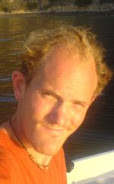SWEAT THE HEAVY ANCHORS
The sunrise is nice, then I get to work heaving the anchor. It must've been in deep water, because I could barely pull it up, so heavy was the length of chain leading to the bottom. The Pearl has a super thick 3/8 inch chain which weighs, I'm guessing, about 5 lbs per foot; in 40 feet of depth, that's 200 lbs, plus the 30 lbs anchor. I try to recruit the help of the windlass but manage to get it jammed, since I don't know how to use it properly. I'm dripping with sweat, inch by inch, my back feeling the workout, and finally we're clear and motoring away.

SOLO SMALL SURFING
At Marmetta, the waves are small, waist to chest high, but as usual it's a lot more fun that it looks. Plus there's nobody else out here, so I take my pick of the longer, fast rights, and occasionally the punchy, bowl-shaped lefts. The wave is very similar to Lower Trestles, fun for anyone from expert to beginner. I'm in my boardshorts for the first session, but the water is much colder than I expected, probably 63 degrees, whereas this time last year it was over 70, so I'm paddle back to the boat for a full suit and a snack.

After a second session, I call it a day and venture over to Albert's, where I'm hoping to find some smooth water to relax for the evening. The incessant rolling aboard the boat is frying my nerves, which is bizarre because I've been living on anchor all summer in Santa Barbara without too much worry. The East Beach anchorage is rougher, in fact, but the swell comes consistently from the south-west; such that a bow and stern anchor keep the boat pitching, which is much more comfortable than rolling. Out here, the lumpy seas and surge seem to throw the boat around despite the 2 anchors.


















